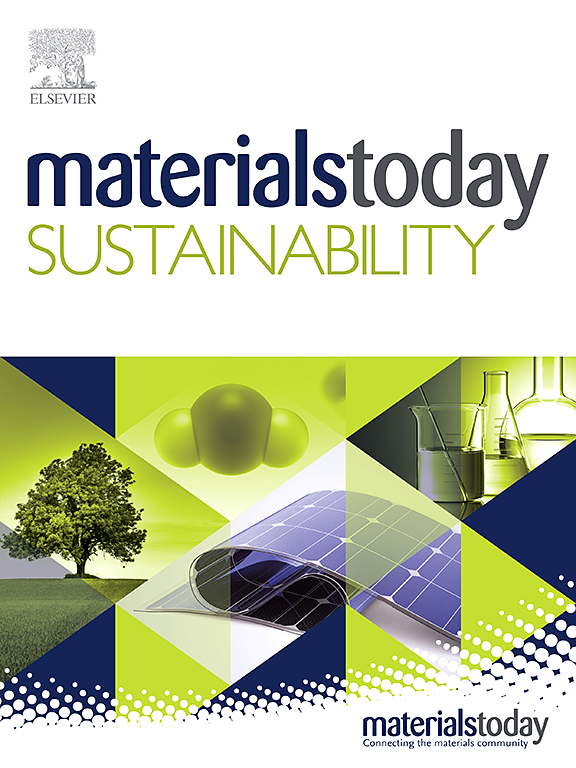由蛋壳膜PVA/姜黄素纳米纤维制成的绿色、可持续、环保的智能变色传感器,用于实时监测鸡肉新鲜度
IF 7.9
3区 材料科学
Q1 GREEN & SUSTAINABLE SCIENCE & TECHNOLOGY
引用次数: 0
摘要
本研究提出了一种用于实时监测鸡肉腐败的可持续荧光传感器(PE-L-C-Cur)的开发。该传感器通过姜黄素的可见色移来检测腐败,以响应由挥发性化合物(如生物氨和胺)引起的pH变化。以聚乙烯醇(PVA)和蛋壳膜(E)为原料,以柠檬提取物为溶剂和交联剂,涂以姜黄素(Cur)绿色乙醇提取物,制备了一种交联静电纺纳米复合材料(PE-L-C)。全面的光谱、微观和分析表征证实了PE-L-C-Cur的结构、形态、热学和功能特性,以及其优异的耐水性、光学性能和防潮特性。该传感器在4天内显示出显著的总色差(ΔE)为51.85(0天:0.0至27.52;1天:27.52 - 32.64;2天:32.64 - 33.58;3天:33.58 ~ 42.23;4天:42.23 ~ 51.85),可以目视检测腐败。此外,PE-L-C-Cur对大肠杆菌和金黄色葡萄球菌具有较强的抗菌活性,提高了热稳定性和生物降解性。它的绿色,具有成本效益和可重复使用的性质使其成为智能食品包装应用,减少浪费和预防食源性疾病的有希望的候选者。本研究成功开发了一种可持续的姜黄素涂层荧光传感器,突出了其在鸡肉实时新鲜度监测和智能包装应用方面的潜力。本文章由计算机程序翻译,如有差异,请以英文原文为准。

Green, sustainable, and eco-friendly smart halochromic sensor derived from eggshell membrane-based PVA/curcumin nanofibers for real-time monitoring of chicken freshness
This study presents the development of a sustainable halochromic sensor (PE-L-C-Cur) for real-time monitoring of chicken spoilage. The sensor detects spoilage through a visible color shift of curcumin in response to pH variations induced by volatile compounds such as biogenic ammonia and amines. A crosslinked electrospun nanocomposite (PE-L-C) was fabricated using polyvinyl alcohol (PVA) and eggshell membrane (E), with lemon extract serving as both a solvent and crosslinking agent, followed by coating with a green ethanolic extract of curcumin (Cur) to form the halochromic sensor. Comprehensive spectroscopic, microscopic, and analytical characterization confirmed the structural, morphological, thermal, and functional properties of PE-L-C-Cur, along with its excellent water resistance, optical properties, and moisture barrier characteristics. The sensor exhibited a significant total color difference (ΔE) of 51.85 over four days (0 days: 0.0 to 27.52; 1 day: 27.52 to 32.64; 2 days: 32.64 to 33.58; 3 days: 33.58 to 42.23; 4 days: 42.23 to 51.85), enabling visual detection of spoilage. Additionally, PE-L-C-Cur demonstrated strong antibacterial activity against E. coli and S. aureus, enhanced thermal stability, and biodegradability. Its green, cost-effective, and reusable nature makes it a promising candidate for smart food packaging applications, reducing waste and preventing foodborne illnesses. This study successfully develops a sustainable curcumin-coated halochromic sensor, highlighting its potential for real-time chicken freshness monitoring and smart packaging applications.
求助全文
通过发布文献求助,成功后即可免费获取论文全文。
去求助
来源期刊

Materials Today Sustainability
Multiple-
CiteScore
5.80
自引率
6.40%
发文量
174
审稿时长
32 days
期刊介绍:
Materials Today Sustainability is a multi-disciplinary journal covering all aspects of sustainability through materials science.
With a rapidly increasing population with growing demands, materials science has emerged as a critical discipline toward protecting of the environment and ensuring the long term survival of future generations.
 求助内容:
求助内容: 应助结果提醒方式:
应助结果提醒方式:


